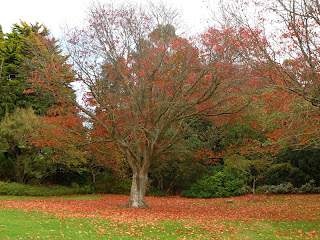It was so beautiful today!!! We saw the most sun we have had on a single day here - yahoo! Loved it! It was quite warm also - actually went without a coat a few times during the day. Today was our last day touring Ireland. We hate to see our Irish holiday come to an end! I found a different cold/flu medicine last night so I was able to take that today and it help tremendously. I felt a lot better!
This used to be a Presbyterian Church and Assembly Hall built in 1905.
It is now the Spires Shopping Mall. It was across from our hotel.
Hillsborough Fort lies just outside the village of Hillsborough in County Down. Set in the beautiful Hillsborough Forest Park and built on the site of the old Magennes stronghold, the Fort was founded in 1630 by Peter Hill and completed around 1650 by Colonel Arthur Hill. The Fort consists of a square enclosed by an earthen rampart with outer stone facing. This stone facing rises above the rampart level to form a parapet wall. (virtualvisit-northernireland.com)
Church near the fort...
Hillsborough Castle, which is located in the village of Hillsborough, County Down, is not a true castle. It is a Georgian mansion built in the 18th century for the Hill family, Marquesses of Downshire, who owned it until 1922 when the sixth marquis sold the mansion and its grounds to the British government. It is now an official government residence in Northern Ireland. It is the residence of the Secretary of State for Northern Ireland, and the official residence in Northern Ireland of HM Queen Elizabeth II and other members of the British Royal Family when they visit the region, as well as a guest house for prominent international visitors. From 1922 until 1972 it was the residence of Governor of Northern Ireland. (Wikipedia)
We were unable to tour it or get past the fences due to it being in use...
Here are some townhomes/row houses near the "castle" - I love the chimneys and the red door!
Saint Patrick's Church is a Church of Ireland church in Newry, County Down, Northern Ireland. The church was built in 1578 on the instructions of Nicholas Bagenal, who was granted the monastery lands by Edward VI, and is considered to be the first protestant church in Ireland. The church was however rebuilt in its current form in 1866. The church sits on a hill on Church Street on the east side of the city and occupies a commanding position overlooking the city centre. The church is notable for its unusual spire - consisting of a small steeple at each corner of the clock tower. (Wikipedia)
Colorful buildings in the town of Newry...
Mellifont Abbey, located in County Louth, was the first Cistercian abbey to be built in Ireland. Founded in 1142 on the orders of Saint Malachy, Archbishop of Armagh, Mellifont Abbey sits on the banks of the River Mattock. By 1170, Mellifont had one hundred monks and three hundred lay brothers. The Abbey became the model for other Cistercian abbeys built in Ireland, with its formal style of architecture imported from the abbeys of the same order in France; it was the main abbey in Ireland until it was closed in 1539, when it became a fortified house. (Wikipedia)
This sign was at a park near a castle. I had to read it several times before it made any sense to me...
View from parking lot:
Ardgillan Castle is a large country house in Balbriggan, Fingal, Ireland. It is set on 200-acres. The house was built by the Reverend Robert Taylor in 1738. Featuring castellated embellishments, the building overlooks Barnageera Beach, the Irish Sea and Skerries. (Wikipedia)
Malahide Castle, parts of which date to the 12th century, lies, with over 260 acres of remaining estate parkland (the Malahide Demesne Regional Park), close to the village of Malahide, nine miles north of Dublin. (Wikipedia)
There were a lot of people milling around this castle. Looked like several school field trips. The cost to do a tour was quite expensive so we passed on doing that. It was a pretty cool looking castle and grounds.
Howth was originally just a small fishing village, but with its surrounding rural district it is now a busy suburb of Dublin, with a mix of dense residential development and wild hillside, all on the peninsula of Howth Head.
There were some clouds that were VERY low while we were in Howth. Made for some cool pictures!
Howth Harbor Lighthouse
A Martello Tower
We are back in Dublin for the night. We finished circling the entire island of Ireland! What a thrilling holiday we have had. While the trip seemed to go very slowly, we can't believe it is over already. We fly home in the morning. We have had a lovely time in Ireland. The scenery was fantastic and the people were extremely friendly. We would love to go back someday...
Thanks for sharing in my reminiscing of our trip to Ireland. I am glad you stopped by.


















































































